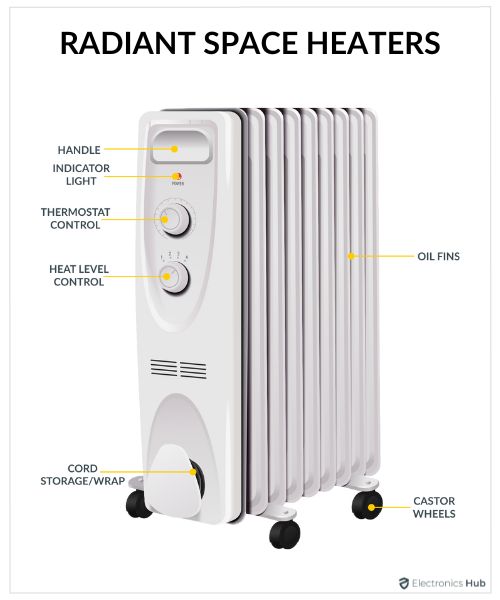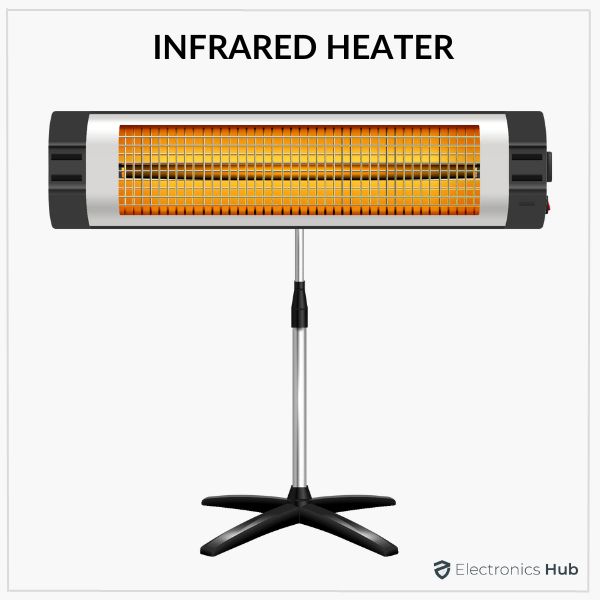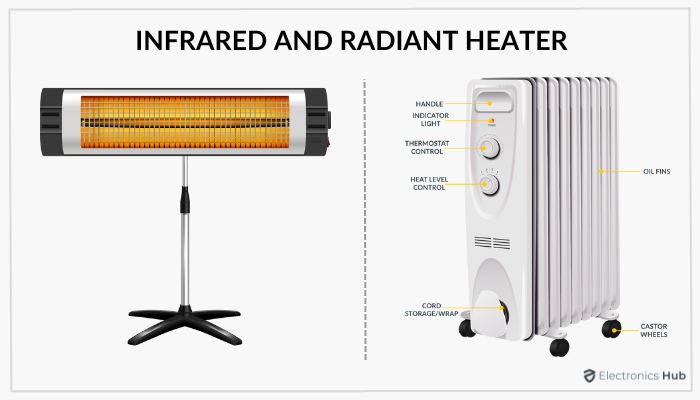As that chilly winter breeze hits your skin, you start preparations to make you and your family warm and cozy for a winter that is on the horizon. If you have a fireplace in your house, you can use firewood and feel the warmth in the living room. But what about bedrooms or patios? This is where room heaters or space heaters come in handy. There are a variety of options to choose from such as electric, oil-filled, propane, etc. While researching different types of heaters, you will encounter two terms which are Infrared Heater and Radiant Heater. What exactly are they? How do they work? How to compare Infrared vs Radiant heaters?
In this guide, we will see the basics of Infrared Heaters and Radiant Heaters. We will also look at their differences (or are they different at all?). As this topic can be confusing for first-time heater buyers, we hope that this guide could help you understand the terms clearly.
Outline
ToggleWhat is a Radiant Heater?

A nuclear fusion of hydrogen atoms into helium releases a huge amount of energy in the sun. This energy is what keeps the sun hot and radiates heat and light across the solar system.
So, Radiant Heating is a process that transmits thermal energy through electromagnetic radiation. When these radiations are intercepted by people or objects, they convert the energy to heat. The amount of energy they radiate is directly proportional to the temperature.
An interesting point about Radiant Heating is it doesn’t impact the surrounding environment or the medium i.e., the air between the heater and the object (humans). In this sense, Radiant Heating is different from Conduction or Convection. Also, radiant heaters are contactless heaters i.e., you can sit far from the heater and still feel the warmth.
Characteristics of Radiant Heaters
- They are directional heaters i.e., only people or objects directly in front of the heater can feel the heat.
- Radiant Heaters are almost instant i.e., they start radiating heat within seconds you turn them on. Also, when you turn them off, they immediately cool off (takes a couple of seconds but still cools down quicker).
- The medium, which is air in our case, isn’t affected by radiant heaters. The heat from the radiant heater travels through the air but doesn’t lose its energy.
- The intensity of heat is dependent on the temperature of the heater as well as the distance it travels (will be warmer if you are close to the heater).
Types of Radiant Heaters
- Electric Heaters: One of the most common and popular types of radiant heaters is electric heaters. When you pass electricity through a metal coil, it will glow red hot and radiate heat.
- Hydronic Heaters: This is a popular option for setup a full house heating system. In this, we have a boiler, a pump, and a network of pipes that run through the floor, walls, or ceiling of a house. As the boiler heats the water, the pump circulates it through the pipes. The heat transfers from the pipes to the surface (floor, concrete, tiles, etc.) and radiates into the room.
- Air Radiant Heaters: Hot Air Tubes carry hot air and radiate heat similar to hot water. But this type of radiant heating is not at all efficient as air cannot hold huge amounts of heat.
What is an Infrared Heater?

When these waves touch the surface of humans or any objects, they release energy as heat and we will feel the warmth. The surrounding air doesn’t get warm when you turn on an Infrared Heater.
Electricity is a popular way to produce infrared heating. Other than this, we have infrared heaters that run on propane and natural gas.
A typical Infrared Heater consists of a heating element (that uses electricity or propane) and a reflective panel. That’s it. the heating element converts electricity (or chemical energy of propane) into thermal energy and radiates it as Infrared Radiation. The reflective panel helps in directing the heat to a single direction or a spot.
Types of Infrared Heaters
- Electric Infrared Heaters: A metal wire, which is usually made up of nickel–chromium alloy (also known as Nichrome Wire), is wound in a metal tube (which is electrically insulated). When we pass electricity through this wire, a concept known as Joule Heating produces heat and is then radiated into the surroundings.
- Gas Infrared Heaters: Natural Gas or Propane is the most common fuel for Gas Infrared Heaters. A burner (which is the heating element) takes the gas and creates combustion. As long as there is a supply of the gas, the burner continues the combustion and produces flames. The thermal energy from these flames is radiated as infrared waves.
Differences Between Infrared vs Radiant Heater

So, instead of Infrared vs Radiant Heater, it should be Infrared or Radiant Heater as they represent the same type of heater.
Infrared Heaters radiate thermal energy in the form of infrared waves, which are a type of electromagnetic wave. In Radiant Heaters, we said the same thing i.e., they radiate heat through electromagnetic radiations.
The term “Radiant Heater” can describe a wide range of heaters that radiate thermal energy using electromagnetic waves. Infrared Heaters on the other hand use a specific portion of the electromagnetic spectrum i.e., the Infrared Waves.
Even though a radiant heater (for instance our Sun) radiates energy in all wavelengths and frequencies, it is the Infrared region of the electromagnetic spectrum that is responsible to carry the thermal energy.
Advantages of Radiant or Infrared Heaters
Now that we know both Infrared Heaters and Radiant Heaters mean the same thing, let us finish this discussion with a couple of advantages and disadvantages.
- Radiant or Infrared Heaters are directional heaters i.e., they radiate thermal energy directly in front or under them (in the case of ceiling-mount heaters).
- They are extremely silent. There are no fans, no boiling water, etc. to make any noise.
- Infrared Heaters do not produce any harmful substances or gases into the air. Even propane heaters do not release Carbon dioxide or other greenhouse gases. However, they release a minute amount of Carbon Monoxide.
- The heat or warmth from Radiant or Infrared Heaters feels natural (similar to the heat from the Sun).
- Radiant Heaters or Infrared Heaters are instant i.e., the moment you turn them on, you can feel the warmth. This is of course huge contrast to Oil Space Heaters, which work over convection. Also, they cool down immediately after you turn them off.
- They don’t heat the surrounding air. So, your skin doesn’t become dry.
- As there are no mechanical parts, Radiant or Infrared Heaters are long-lasting. With occasional cleaning, you can use them for years.
- You have several design choices for both electric as well as propane heaters.
- Propane Heaters are much more efficient than electric heaters.
- You can use them both indoors and outdoors.
Disadvantages of Radiant or Infrared Heaters
- The heater element, whether it is an electricity carrying wire or fuel burning element, is usually exposed. Even though there will be a protective mesh or grill in front of it, you need to be very careful around it.
- As they are directional heaters, they work as spot heaters. So, you cannot expect them to heat a large room or a large area.
- Radiant Heaters or Infrared Heaters are generally less efficient when compare to convection-based heaters (such as Oil Space Heaters).
Conclusion
The terms Infrared Heater and Radiant Heater might be confusing to people who are looking at electric heaters for their homes for the first time.
In this guide, we saw the basics of Infrared Hearting and Radiant Heating and concluded that both Infrared Heaters and Radiant Heaters are in fact one and the same. So, the correct term should be Infrared or Radiant Heater instead of Infrared vs Radiant Heater.
We also saw the advantages and disadvantages of Infrared or Radiant Heaters. If you feel we missed something or want us to add anything, do let us know in the comments section. It will not only help us but also other readers.

